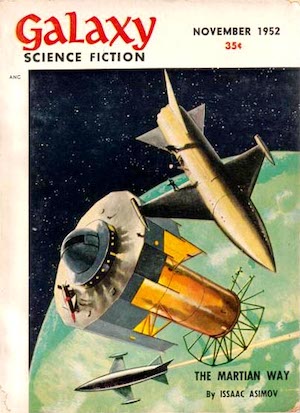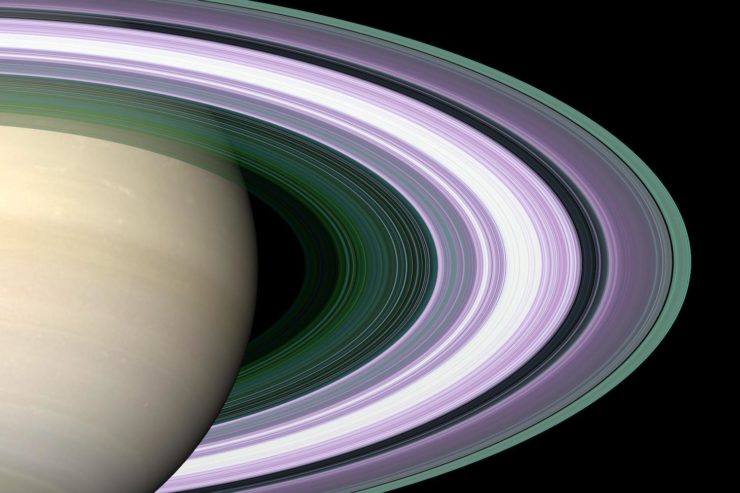The mediocrity principle suggests there’s probably nothing special about our Solar System. There are millions of planets in our galaxy; if we were to randomly pick one, it would be likely to be a common sort of planet, from the middle of a normal standard distribution. Sure, we have an outsized, heavy-element-rich sun, and the distribution of planets in our system appears unusual, but there must be aspects of our Solar System that could be found in other Milky Way systems.
Which brings me, conveniently enough, to the subject of planetary rings.
For many centuries (from the invention of telescopes until relatively recently), the only planetary rings we knew were those circling Saturn. They were large; they had a high albedo; they were noticeable. We’ve discovered of late that our Solar System features yet more rings. Jupiter, Saturn, Uranus, and Neptune all have ring systems, as do the far smaller bodies Chariklo and Haumea. Chiron may have rings as well. Saturn’s are still the finest. Yay Saturn!
(An aside: It might be a good idea to list Saturn’s rings as a UNESCO Heritage Site now, to preserve them from ambitious volatile prospectors.)

But rings are generally found within the planet’s Roche Limit, which as a corollary means that the delta-v to recover material from them is high, particularly when compared to other icy worlds. Gravity alone may prevent Mr. Peabody’s coal train from hauling the rings away.]
The mediocrity principle would suggest that other ring systems exist—systems that may be even more spectacular than Saturn’s. Recent discoveries hint that this may be the case. Data from the star 1SWASP J140747—have I complained yet today that astronomers are terrible at naming things?—suggests that its substellar companion may have a ring system that could be 180 million kilometers wide. That is about 30 million kilometers more than the distance from the Earth to the Sun. If Saturn had a ring system like that, it would be naked-eye visible.
Unfortunately for ambitious starfarers looking to tour the scenic spots of the galaxy, 1SWASP J140747 is about 420 light years away. Granted, on a galactic scale, that’s right next door. On the scale of any technology we’re likely to develop any time soon, it is well out of reach. Perhaps there’s something closer to hand?
As you all know, Proxima Centauri is currently the closest known star to our Sun; it is currently about 4.2 light years away (slightly closer at present than the two Sun-like stars around which it orbits). Whereas it would take a human-built spacecraft about as long to reach 1SWASP J140747b as the time that’s elapsed since the appearance of hominins, Proxima is a mere 70,000 years away by chemical rocket. Even better, it’s getting closer—in 27,000 years or so it will be a mere three light years or so from Sol! That knocks more than 15,000 years off the travel time!
We might want to do more R&D on rocket propulsion before setting out for Proxima.
Proxima might, at present, be best known for the terrestrial world sitting in the red star’s hilariously tiny habitable zone. Proxima b is a world that is, depending on which models one prefers, somewhere on the scale of habitable worlds between “verdant garden” and “radiation-soaked airless corpse.” Pretty exciting result for the system nearest ours! It may not be the only world orbiting the dim star, however.
There is fair evidence for a Proxima c. Data suggests that it orbits Proxima at a distance about fifty percent greater than from the Earth to the Sun. Due to Proxima’s low mass, this orbit takes more than five years. Due to Proxima’s low luminosity, the planet might be somewhere around 40 K (cold enough to freeze nitrogen solid without being quite cold enough for neon snow). Insert large error bars, here, as needed. It appears to be a super-Earth world, or perhaps a mini-Neptune. According to the catchily titled Searching for the near infrared counterpart of Proxima c using multi-epoch high contrast SPHERE data at VLT, Proxima c may also have a ring system.
Although results are currently equivocal, if Proxima c’s ring system exists, it’s two or three times larger than Saturn’s. Because c is five to ten or so Earth-masses, as opposed to Saturn’s 95 Earth-masses, c’s rings are much larger in comparison to c than Saturn’s are in comparison to the actual planet. Since rings systems are thought to be dynamic, short-lived phenomena, this implies exciting events in the recent past (meaning “recent” on a cosmological scale). While we don’t know for sure what might be found in the Proxima system, we can rule out large gas giants of the sort that have pruned our Solar System into the well-ordered state with which we are familiar. Despite being slightly older than the Solar System, Proxima’s system may be more chaotic. Or, as was the case for the precursor of Saturn’s rings (a pulverized moon), Proxima c’s moons were rather unlucky.
No doubt Proxima c’s rings are an impressive sight, and just 70,000 years away by conventional rocket! Make your reservations now!
In the words of Wikipedia editor TexasAndroid, prolific book reviewer and perennial Darwin Award nominee James Davis Nicoll is of “questionable notability.” His work has appeared in Publishers Weekly and Romantic Times as well as on his own websites, James Nicoll Reviews and Young People Read Old SFF (where he is assisted by editor Karen Lofstrom and web person Adrienne L. Travis). He is currently a finalist for the 2020 Best Fan Writer Hugo Award and is surprisingly flammable.










